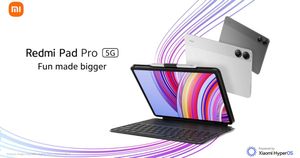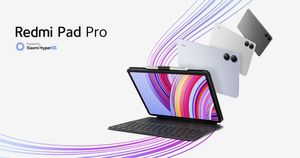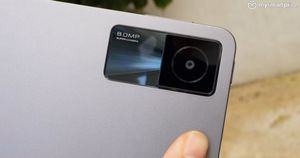
In April this year, Xiaomi sought to test whether India was a viable market for tablets. So they brought the Xiaomi Pad 5 in limited quantities, which brought about a unique turn of events. Not only did it go out of stock within three days of launch, but it also created a demand in the market. Soon enough, other tablets were launched within a span of a few months from brands like Motorola, Oppo and Realme. Now, in the midst of the festive season, an affordable, refined version of the Pad 5 was launched in the form of the Redmi Pad.
The key selling highlights are straightforward, Redmi has focused on four primary areas – display, battery life, performance and price and boy, did they price it cheap. Without offers, the Redmi Pad starts at Rs 14,999. That’s right, a tablet with the same processor as the POCO M5, twice its battery capacity and screen size and zero bloat are available at a premium of just Rs 2,500! So, is it the ultimate festive season purchase? Find out in our review.
Redmi Pad Review: Design and build
Given that the Redmi Pad is way more affordable than the Xiaomi Pad 5, it would be obvious that it would be a watered-down version of it. But, instead, it is, on some occasions, better than the latter, at least in terms of build.
The Redmi Pad has an all-metal body made of Aluminium Magnesium alloy, which helps it stay light at 465g. It is also slim, spanning 7.5mm on its thinnest side. It is well-weighted, so it feels centred when held in hand. The texture of the metal is also coarse, which aids in gripping the tablet better. The Xiaomi Pad 5, in contrast, had a plastic rear.
Another improvement comes in the selfie camera placement – the Xiaomi Pad 5 had one on the narrower side, making awkward conference calls. The Redmi Pad hosts the front shooter on the wider side so that you can take advantage of the display in landscape mode.
It skips four magnetic pins that let the Xiaomi Pad 5 connect to a physical keyboard, and this time there’s no promise for proprietary accessories either. There’s also no 3.5mm jack and IR blaster in the Redmi Pad. We haven’t seen the latter being skipped in a Redmi device in a long time.
In terms of physical features, the right side of the Redmi Pad hosts the volume rocker, two mics, and a SIM tray. The top has two speakers and the power button, whereas the left is entirely clean. The bottom has two more speakers and a USB Type-C port.
The Redmi Pad is IP52-rated for dust and water resistance, but there’s no display protection of any kind, so you may want to either keep this holstered within a keyboard folio case or apply a screen protector.
Redmi Pad Review: Display
While we were complaining about the display’s durability just a line ago, the display itself is a joy to use for any device, let alone a tablet, at this price. So, we have a sprawling 10.61-inch display with a resolution of 2000×1200, yielding an aspect ratio of 15:9. It keeps things smooth, thanks to a 90Hz panel. This may seem like a tiny improvement over a 60Hz display in terms of numbers, but in reality, it does wonder.
 You also get good colour reproduction as this is a 10-bit panel, another rarity in the segment. It is capable of 70% NTSC coverage. Peak brightness is decent at 400 nits.
You also get good colour reproduction as this is a 10-bit panel, another rarity in the segment. It is capable of 70% NTSC coverage. Peak brightness is decent at 400 nits.
We compared the Redmi Pad’s display with the Realme Pad X we just reviewed a few days ago. Both panels have similar resolution and brightness, but the Pad X doesn’t seem to stream 1440p videos on YouTube, whereas the Redmi Pad does. While we are at it, you also get three free months of YouTube Premium subscription with the Redmi Pad.
The colour banding is also lesser on the Redmi Pad, thanks to 10-bit support, and it also registers touch inputs far quicker than the Pad X.
Thanks to Widevine L1 compliance, content on Netflix, Prime Video and Hotstar can be viewed in HD quality, but Dolby Vision and HDR cannot be applied here as it’s missing on the hardware level. This is entirely fine for its price.
Flanking the display are four Dolby Atmos-tuned speakers, but here’s the cool bit – the Video Toolbar overlay exclusive to MIUI helps you adjust the level of Atmos’ Dialogue Enhancement feature in notches, which is something we haven’t seen before in tablets or smartphones. It’s not a night-and-day difference, but it does help you listen to movie dialogues much better. The overall audio output of the speakers is very similar to that of the Pad X, though – they can get loud, the depth and the low-end thump are still lacking.
Redmi Pad Review: Performance and software
Powering the Redmi Pad is a MediaTek Helio G99 SoC, marking its debut on a tablet. It yields a big advantage to the Pad, as other tablets in the segment tend to cheap out on performance. The processor is paired with three RAM and storage configurations of 3GB/64GB, 4GB/128GB and 6GB/128GB, the last of which we received.
 All this is run by MIUI 13 based on Android 12, there’s no bloatware here either. We want to highlight this interesting thing about the tablets we reviewed in 2022 – they usually do not include bloatware! The reason behind this is still unclear. No bloatware doesn’t mean no special features; it does have the same Xiaomi special settings found in other MIUI devices as well.
All this is run by MIUI 13 based on Android 12, there’s no bloatware here either. We want to highlight this interesting thing about the tablets we reviewed in 2022 – they usually do not include bloatware! The reason behind this is still unclear. No bloatware doesn’t mean no special features; it does have the same Xiaomi special settings found in other MIUI devices as well.
In terms of sheer speed, the Redmi Pad offers good benchmark figures. In Geekbench v5, it scored 544 and 1802 in single and multi-core tests, respectively. In AnTuTu v9, it secured 339469. Both scores are in the same ballpark as the POCO M5 we recently reviewed, and unsurprisingly, the gaming performance is nearly identical. However, real-world use is marginally better, thanks to the lack of bloat. There’s also no theme store to send you unsolicited notifications.
FPS gaming is a big ask for a tablet at this price, but it still manages to churn out Medium graphics and high frame rates on Call of Duty: Mobile, but there was still some stuttering. This isn’t a tablet for serious gaming. Casual gaming is manageable, we played Leo’s Fortune and Odyssey, and both ran smoothly.
In day-to-day use, the Redmi Pad shines, mainly because of the ‘dock’ that we absolutely love in the Pad 5. It lets you do iPad-like things, like quickly accessing previously opened apps and even accommodates up to six pinned apps. In addition, two pill-shaped quick access shortcuts will help you use the dock if you’re using gesture controls.
The RAM management is not that good, and the Redmi Pad would often shut down apps in the background to make room for the app in use. We also saw it in the Realme Pad X, and we are seriously worried about how the base variant will perform. We asked Xiaomi about the same, and they were confident that MIUI 13 is also optimised for low RAM.
Compared to the immediate competition from Oppo Pad Air and Moto Tab G62, the Redmi Pad is slightly better in perceived speed, mostly because of its 90Hz display.
Redmi Pad Review: Battery performance
The Redmi Pad packs an 8,000mAh battery and ships with a 22.5W charger and a Type-A to Type-C cable. In typical Xiaomi fashion, charging on the Redmi Pad maxxes out at 18W.
 Standby times are decent, and it loses about 7% over an entire day on being unused.
Standby times are decent, and it loses about 7% over an entire day on being unused.
On a single charge with about 3 hours of movie and TV series watching and a couple of hours more of some web and social media surfing, the Xiaomi Pad lasted about three days on a single charge. This isn’t terrible by any means, but it is slightly lower than what the Realme Pad X has to offer. Charging times are also long because charging that mammoth of a battery takes about three hours to charge entirely. This isn’t as bad because tablets aren’t usually primary devices and can charge in the background as you work or do other things in life.
Redmi Pad Review: Verdict
 The Redmi Pad is the mass-friendly version of the Xiaomi Pad 5, which seems more like a proof of concept at this point. It feels premium in hand and has a nice and smooth display and a clean UI that often feels snappy. It does its media consumption duties well and for an extremely affordable price. However, it’s not meant for heavy gaming. It lacks any kind of display protection and skips the headphone jack, which may be a downer for many students. We also wish it had a 4G/LTE variant.
The Redmi Pad is the mass-friendly version of the Xiaomi Pad 5, which seems more like a proof of concept at this point. It feels premium in hand and has a nice and smooth display and a clean UI that often feels snappy. It does its media consumption duties well and for an extremely affordable price. However, it’s not meant for heavy gaming. It lacks any kind of display protection and skips the headphone jack, which may be a downer for many students. We also wish it had a 4G/LTE variant.
In its lowest configuration, it competes with the Realme Pad, Oppo Pad Air and the Moto Tab G62, but in the best configuration, it straight up beats the Realme Pad X in its base variant. If you wish to consider the competition, do it only if you’re getting 4G connectivity.
We recommend getting the top configuration if you can, as 6GB of RAM will help you future-proof your purchase, paying dividends in the long run.




























